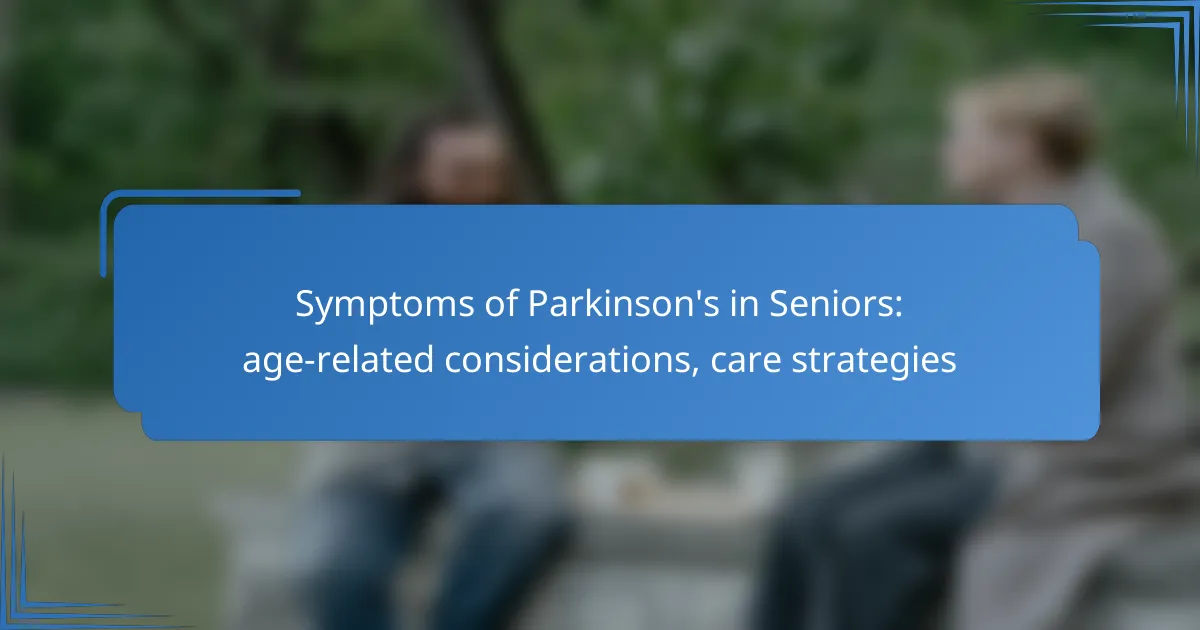Parkinson’s disease presents unique challenges for seniors, with common symptoms such as tremors, stiffness, and cognitive changes significantly affecting daily life. Effective management requires tailored care strategies that consider the natural progression of the disease and the complexities introduced by aging. Caregivers play a vital role in supporting seniors through medication management, physical and occupational therapy, and community resources to enhance their quality of life.

What are the common symptoms of Parkinson’s in seniors?
Common symptoms of Parkinson’s in seniors include tremors, stiffness, slowness of movement, postural instability, and cognitive changes. These symptoms can significantly impact daily living and require tailored care strategies to manage effectively.
Tremors and shaking
Tremors are often one of the first noticeable symptoms of Parkinson’s, characterized by involuntary shaking, typically starting in the hands or fingers. In seniors, these tremors may be more pronounced during rest and can diminish during purposeful movement.
Managing tremors may involve medication adjustments or therapies such as occupational therapy to help seniors adapt their daily activities. Simple strategies like using weighted utensils can also provide stability during meals.
Stiffness and rigidity
Stiffness and rigidity in muscles can lead to discomfort and reduced mobility in seniors with Parkinson’s. This symptom often manifests as a feeling of tightness in the limbs and trunk, making it difficult to initiate movement.
Regular physical therapy can help alleviate stiffness, focusing on stretching and strengthening exercises. Seniors should be encouraged to engage in gentle activities like yoga or tai chi to improve flexibility and reduce muscle tension.
Bradykinesia (slowness of movement)
Bradykinesia refers to the noticeable slowness of movement, making everyday tasks take longer to complete. Seniors may find it challenging to start walking or may have a shuffling gait, which increases the risk of falls.
To combat bradykinesia, caregivers can assist by providing cues or prompts to encourage movement. Breaking tasks into smaller steps and allowing extra time for completion can also help seniors manage their daily routines more effectively.
Postural instability
Postural instability is a common symptom that affects balance and coordination, leading to an increased risk of falls. Seniors may have difficulty maintaining an upright position, especially when turning or changing direction.
Implementing safety measures at home, such as removing tripping hazards and using assistive devices like canes or walkers, can help mitigate fall risks. Balance training exercises under professional supervision can also enhance stability.
Cognitive changes
Cognitive changes in seniors with Parkinson’s can include memory problems, difficulty concentrating, and slower processing speeds. These changes may not be as visible as physical symptoms but can significantly impact daily life.
Engaging in mentally stimulating activities, such as puzzles or reading, can help maintain cognitive function. Regular check-ins with healthcare professionals can ensure that any cognitive decline is monitored and managed appropriately.

How can caregivers manage Parkinson’s symptoms in New Zealand?
Caregivers in New Zealand can effectively manage Parkinson’s symptoms by implementing a combination of medication management, physical therapy, occupational therapy, and utilizing community resources. Understanding the specific needs of seniors with Parkinson’s is crucial for providing tailored support and improving their quality of life.
Medication management strategies
Effective medication management is essential for controlling Parkinson’s symptoms. Caregivers should ensure that medications are taken as prescribed, which may include levodopa and dopamine agonists. Regular consultations with healthcare providers can help adjust dosages based on the patient’s response and side effects.
It is beneficial to maintain a medication schedule and use pill organizers to prevent missed doses. Caregivers should also monitor for any adverse reactions and communicate these to healthcare professionals promptly.
Physical therapy options
Physical therapy can significantly improve mobility and reduce stiffness in seniors with Parkinson’s. Caregivers should encourage participation in tailored exercise programs that focus on strength, flexibility, and balance. Activities such as tai chi or gentle yoga can be particularly effective.
Regular physical therapy sessions, ideally conducted by a trained physiotherapist, can help seniors maintain their independence and reduce the risk of falls. Caregivers should also incorporate daily walking or simple stretching exercises into the routine.
Occupational therapy techniques
Occupational therapy focuses on enhancing daily living skills for seniors with Parkinson’s. Caregivers can work with occupational therapists to identify adaptive tools that make tasks easier, such as modified utensils for eating or grab bars in the bathroom.
Creating a structured daily routine can help seniors manage their time and reduce frustration. Caregivers should encourage the use of visual aids and reminders to assist with memory and organization.
Support groups and community resources
Support groups provide valuable emotional and practical assistance for caregivers and seniors dealing with Parkinson’s. In New Zealand, organizations like Parkinson’s New Zealand offer resources, information, and community connections.
Caregivers should seek out local support groups to share experiences and gain insights from others in similar situations. Additionally, exploring community resources such as respite care services can help alleviate caregiver stress and provide necessary breaks.

What are the age-related considerations for Parkinson’s care?
Age-related considerations for Parkinson’s care include the natural progression of symptoms and the impact of aging on overall health. As seniors age, the management of Parkinson’s becomes more complex due to the interplay of neurological changes and other health factors.
Impact of aging on symptom progression
Aging can accelerate the progression of Parkinson’s symptoms, leading to increased motor and non-motor challenges. Seniors may experience a decline in mobility, balance, and coordination, which can heighten the risk of falls and injuries.
Additionally, cognitive decline may occur alongside physical symptoms, complicating the care process. Regular monitoring of symptom changes is essential to adjust treatment plans effectively.
Coexisting health conditions
Many seniors with Parkinson’s also have coexisting health conditions, such as diabetes, hypertension, or arthritis. These comorbidities can complicate treatment and require careful management to avoid adverse interactions with Parkinson’s medications.
For instance, certain medications for high blood pressure may exacerbate Parkinson’s symptoms, necessitating a coordinated approach between healthcare providers. Regular communication among specialists is crucial for optimal care.
Importance of regular health assessments
Regular health assessments are vital for seniors with Parkinson’s to monitor disease progression and adjust care strategies. These assessments should include evaluations of motor function, cognitive abilities, and overall health status.
Healthcare providers may recommend assessments every few months, depending on the individual’s condition. Keeping a detailed record of symptoms and changes can aid in discussions during these appointments, ensuring that care remains tailored and effective.

How does nutrition affect Parkinson’s symptoms in seniors?
Nutrition plays a crucial role in managing Parkinson’s symptoms in seniors by influencing overall health and well-being. A balanced diet can help alleviate some symptoms, improve energy levels, and enhance the effectiveness of medications.
Dietary recommendations
For seniors with Parkinson’s, a diet rich in fruits, vegetables, whole grains, and lean proteins is beneficial. Foods high in antioxidants, such as berries and leafy greens, may help combat oxidative stress associated with the disease. It’s also advisable to limit saturated fats and sugars to maintain overall health.
Incorporating omega-3 fatty acids from sources like fish or flaxseeds can support brain health. Seniors should aim for a variety of colors on their plate to ensure a wide range of nutrients, which can help manage symptoms effectively.
Hydration importance
Staying hydrated is essential for seniors with Parkinson’s, as dehydration can exacerbate symptoms like fatigue and cognitive decline. Aim for at least 1.5 to 2 liters of fluids daily, adjusting based on individual needs and activity levels.
Encourage the intake of water, herbal teas, and broths. Monitoring fluid intake can help prevent complications such as constipation, which is common in Parkinson’s patients. Consider using reminders or hydration tracking apps to maintain adequate fluid consumption.
Supplements and their effects
Supplements can play a supportive role in managing Parkinson’s symptoms, but it’s essential to consult a healthcare provider before starting any. Common supplements include vitamin D, which may improve mood and bone health, and Coenzyme Q10, which is thought to support cellular energy production.
Some seniors may benefit from B vitamins, particularly B12 and folate, which are important for nerve health. However, it’s crucial to avoid excessive doses, as high levels of certain vitamins can lead to adverse effects. A balanced approach with whole foods should be prioritized over supplements whenever possible.

What are the best assistive devices for seniors with Parkinson’s?
Assistive devices for seniors with Parkinson’s can significantly enhance mobility, safety, and independence. Key options include mobility aids, adaptive utensils, and home modifications that cater to the specific challenges faced by individuals with Parkinson’s.
Mobility Aids
Mobility aids such as walkers, canes, and wheelchairs are essential for seniors with Parkinson’s to maintain stability and prevent falls. Walkers with built-in seats can provide rest during longer outings, while canes offer support without being cumbersome.
When selecting a mobility aid, consider the senior’s strength and balance. Adjustable options can accommodate different heights and preferences, ensuring comfort and effectiveness. It’s advisable to consult with a healthcare professional for personalized recommendations.
Adaptive Utensils
Adaptive utensils are designed to assist seniors with Parkinson’s in eating independently. These tools often feature larger, ergonomic grips and weighted designs to reduce tremors and improve control. Forks and spoons with built-up handles can make a significant difference in daily dining experiences.
Look for utensils that are dishwasher safe and easy to clean. Some products may also include non-slip mats to stabilize plates, which can further enhance the dining experience. Trial and error may be necessary to find the best fit for individual needs.
Home Modifications
Home modifications can create a safer living environment for seniors with Parkinson’s. Simple changes like installing grab bars in bathrooms, using non-slip mats, and ensuring adequate lighting can help prevent accidents and promote independence.
Consider removing tripping hazards, such as loose rugs or clutter, and installing ramps for easier access. Consulting with an occupational therapist can provide tailored solutions that address specific mobility challenges and enhance overall safety at home.
